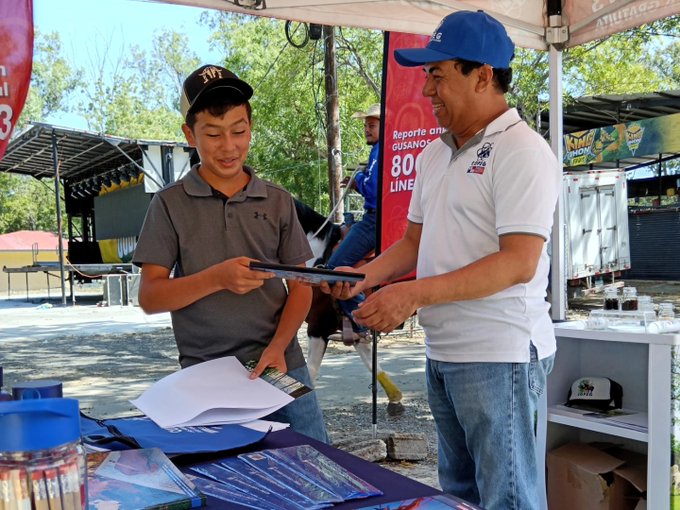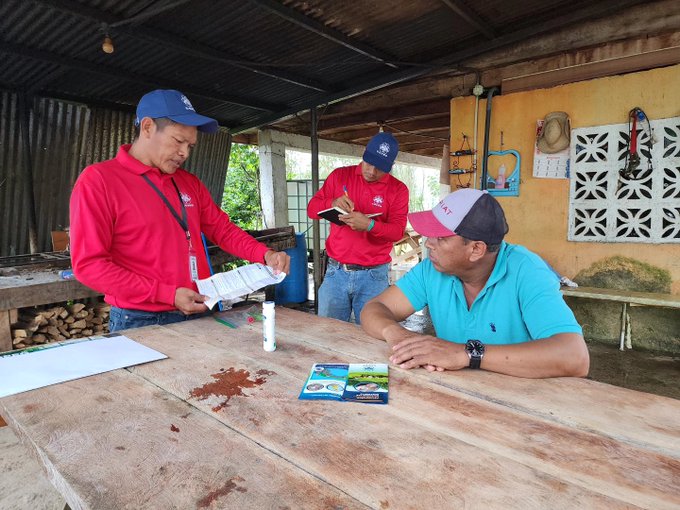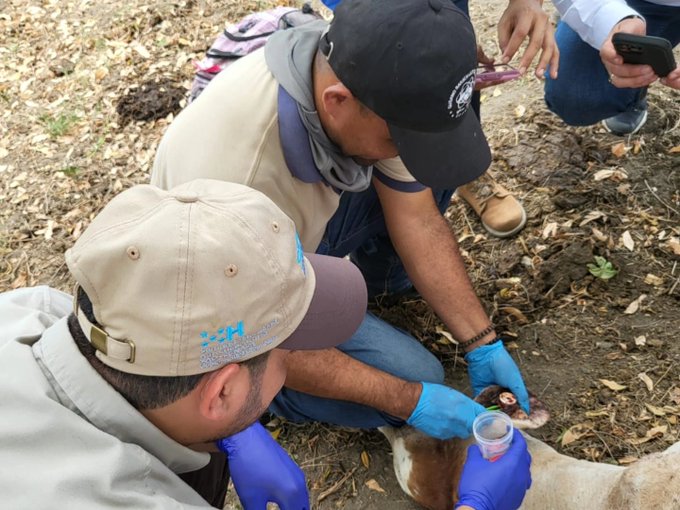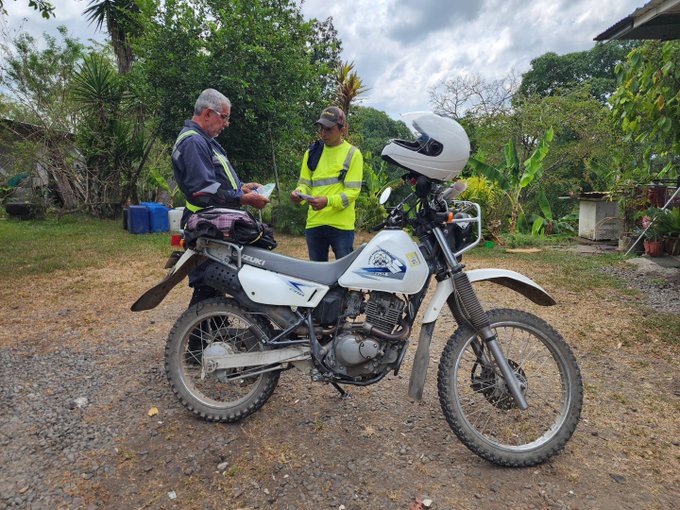If you ever happen to visit southern Panama, there’s a good chance you’ll see a small plane flying overhead. But these planes aren’t carrying excited holidaymakers. Instead, they’ve got some drastically different passengers on-board: screwworms! Despite the wriggly name, these guys are actually a species of fearsome fly, that’ve wreaked havoc around the Americas for centuries. With that said, it might sound strange that over the course of the week, planes will drop nearly 15 million of these buzzing bugs over southern Panama.
While this may sound like a curious case of biological warfare, this puzzling program is designed for one thing, and one thing only! These fly-drops are actually part of a
decades-long collaboration between the U.S and Panama, keeping northern and central America safe from the exact species of fly being dropped from planes! Let's uncover how x-rays, donuts and one boy’s curiosity, led to one of the most adventurous projects in scientific history!
Screwworms
Before we get into how 15 million screwworms ended up getting dumped out of a plane in southern Panama, we need to know who exactly we’re dealing with. And don’t worry, we’ll get to their confusing name in a bit.
These critters love nothing more than dining on living flesh. From cows, to deer, and dogs to human, these critters don’t care what they munch on, as long as its fleshy and got a heartbeat. And things are only gonna get more grizzly from here. Mother screwworms are attracted by the smell of open wounds. After finding a scratch or graze on their victim, they’ll lay their eggs inside it. How many? Just the 400! And here's when the real trouble starts. When hatched, the maggots, which get their name from their screw-shaped worm-like appearance, munch through flesh, creating a larger and larger wound.
Not only is this extremely painful for the host, their screwworm-filled wounds can also become infected, often leading to fatalities. Not that those dreaded screwworms care. Once those menacing maggots have fattened up, they drop off their victim and pupate, before emerging as flies, starting the blood-chilling cycle again. Anyone else got chills?
Turns out those sinister screwworms have been plaguing the planet for centuries. Back in 1858, prisoners at a penal colony on Devil’s Island in French Guiana, were, well, dropping like flies. An investigation revealed that this was caused by an infestation of an eerie insect that was eating the prisoner’s flesh. Samples of the worm-like larvae were collected, and the flies were hatched for study. Dr. Charles Coquerel, a French naval surgeon and insect-guru, first described them, giving them their scientific name, C. hominivorax; which means man-eater.

So, we’ve established, screwworms aren’t your typical fly that cause little trouble other than an irritating buzzing sound, these guys are grizzly killers. And no-one knew that better than American farmers at the start of the 20th century. Screwworms thrive in warm, humid environments, reproducing more rapidly in such conditions. This made the southern U.S farmlands a prime place for infestations. By the 1930s, the situation was so severe that screwworms were killing up to $10 million worth of livestock every year in the southern U.S. Clearly something needed to be done.In fairness, efforts were made to tackle the problem. For instance, livestock breeding schedules were planned to occur in the colder, winter months when screwworm activity was minimal, reducing the risk of infestation in vulnerable newborn animals.
Likewise, procedures like castration and branding, that gave animals wounds, took place over winter too. Thanks to an educational program developed in the 1930s, farmers across southern U.S learned that screwworm cases could be reduced by treating wounds with a colorless liquid known as benzol, as well as pine tar oil.

Though these practices initially helped to reduce livestock losses, they weren’t sustainable long-term solutions to the problem, and each summer, during peak screwworm season, infestation rates would consistently sky-rocket. In fact, in the 1950s, nearly 20 years after initial efforts were made to solve America’s screwworm headache, the agriculture sector was losing up to $100 million a year in livestock losses. Obviously, winter livestock breeding schedules and pine tar oil weren’t doing the trick. Somehow, someone needed to create a plan not to deal with screwworm infestations, but to eradicate these critters entirely! And that’s where Edward Knipling comes in! Born in Texas in 1909, ‘Knip’, as his friends used to call him, grew up on his parents’ small farm. Even as a young kid, Knip didn’t shy away from working on the farm. He later said, that every plant we grew had some type of insect that was causing damage. Even worse, the Knipling’s farm, like so many others suffered with screwworms. One of Knip’s most troubling tasks was treating baby calves that were suffering from dreaded screwworm infestations. As a result, Knip saw first-hand just how devastating these awful insects were, making him determined to find a solution to America’s screwworm problem. In his 20s, Knip found work with the U.S Department of Agriculture, or USDA. In 1931, he was tasked with researching the behavior and lifecycle of his arch-enemy, the screwworm. By 1937, he’d teamed up with a young colleague, Raymond Bushland. Together, the two of them would study the mating habits of screwworm flies.

They observed that male flies mated repeatedly, while female flies mated just once in their lifetime. And with that, the pair of scientists had a lightbulb moment! They believed they’d uncovered a weakness in the screwworm’s life cycle. If a female screwworm mated with a sterile male, she’d produce no offspring. And, because females only mate once in their life, this would significantly reduce the screwworm population. So, if male flies could be produced in large numbers, sterilized, and then released into an environment, they’d overload an area with fertile males. As a result, the female screwworms would more likely mate with sterile males, producing no offspring, and screwworms eradicated!

Sounds perfect. There was just one teeny-tiny problem: how on earth do you go about sterilizing a bunch of male screwworm flies? Just as Knipling and Bushland were frantically trying to finalize their screwworm sterilization plan, the work was brought to a halt. In 1941, the U.S entered World War Two. As a result, their work now shifted to repelling and controlling insects that threatened Allied troops with diseases.Once the war finished, the scientists quickly went back to studying screwworms. Thanks to the horrific consequences of atomic bombs dropped on Japan, scientists now knew that high doses of radiation could damage human tissues and cells. In 1950, equipped with this knowledge, scientist, Hermann Muller, discovered that
fruit flies exposed to radiation via an x-ray could be sterilized. Essentially, the radiation emitted from an x-ray contains enough energy to break up DNA molecules in the reproductive cells of each fly. In males, this results in sperm that fails to produce offspring.
Though Muller’s findings excited Knipling and Bushland, their laboratory didn’t have the equipment or funds to carry out a similar experiment on screwworm flies. Determined to find a solution, Bushland smuggled some screwworms into the X-ray lab of an army hospital in Texas, where some of his friends worked.

As you can already work out, this was a pretty mad idea. First, military bases aren’t exactly keen on people just sneaking into them. Especially when you’re sneaking in parasites that feast on open wounds. And, let’s not forget this was a military hospital, where there will likely be a whole lotta injured humans! Undeterred, Bushland carried out the daring experiment. And it was just as well he did. He discovered that screwworms subjected to x-ray radiation at 5 days old survived, emerging as healthy adults. Even more importantly though, they’d been successfully sterilized! So, these whizzes had figured out how to sterilize screwworms. Knipling and Bushland needed to prove their sterilized males could mate with fertile females in the wild.
Screwworm Erradication
In 1951, the perfect opportunity arose for Knipling and Bushland to test the sterile insect technique, as it became known. Sanibel Island, a 20-square-mile stretch of land found a mile off the coast of Florida, was dealing with a nasty screwworm outbreak, with flies ravaging the island’s goat population.
Considering that Sanibel Island is found a mile off mainland America, it was the perfect place for controlled testing. Sterile male flies were released weekly at a rate of 98 flies per square mile for several months on the island. So, did it work?
Well, as much as 80% of the egg masses collected from infected goats on the island were sterile, meaning they failed to hatch. However, the experiment wasn’t a complete success. Though Sanibel Island is fairly isolated, some plucky fertile males managed to make the one mile migration from the mainland, preventing the population from being completely eradicated. Still, encouraged by the progress they were making, the scientists remained undeterred.
A few years later, in 1954, another opportunity arose for them to test sterile insect technique. This time the Dutch government asked the USDA for help controlling growing screwworm populations that were ravaging goat and cattle on the island of Curaçao, off the coast of Venezuela. Considering Curaçao is over 30 miles away from any other land, there wouldn’t be any fertile fly migration similar to Sanibel Island. As well as being more isolated, Curaçao is also much larger. In all, it stretches over an area of 170 square miles, making it nearly 10 times the size of Sanibel Island. And you know what 170 square miles of space means? A whole bunch of sterile screwworms!

So, a factory for producing screwworms on mass was set up in Orlando, Florida. It looks like Disneyland’s not the only thing in Florida that’ll leave you wide-eyed. At this rearing facility, some 170,000 flies were produced per week, before being sterilized with radiation, and packaged up in carboard boxes. From there they’d be loaded up onto a small plane. Thank god these buzzing bugs were packaged in carboard boxes! Can you imagine how hard it’d be to get thousands of flies to neatly arrange themselves in the back of a plane? A technician seated in the plane had the fun job of steadily dropping the boxes of sterile flies onto the island below. This ensured the entirety of Curaçao was evenly covered. Just as well, imagine if they dropped all those thousands of flies at once? Each week nearly 800 sterile flies were released per square mile of the island.
Incredibly, in less than six months, screwworms were
completely eradicated from Curaçao. In fact, Curaçao remains screwworm-free even today! Whatever those scientists were getting paid, it wasn’t enough!
The success of the sterile insect technique in Curaçao, gave farmers in the southern U.S hope there lands could be cleared of sinister screwworms too. In 1957, a 1,900 square-mile test zone was set up in southern Florida. Before long, an uber-sized product plant was set up in Sebring, Florida, capable of producing 50 million sterile flies per week. Each week, planes armed with armies of sterile screwworms flew overhead in Florida, treating every square mile with over 1,000 flies. Despite the high influx of sterile flies, fertile flies still managed to immigrate into the test zone. Still, screwworm numbers dropped. After three months, 70% of screwworm eggs in the area were sterile, and the population of these brazen bugs dropped by 90%.

With that many sterile screwworms flying about, you won’t be surprised to find out these critters were completely eradicated from Florida by 1959. Following the success of the Florida eradication program, the effort soon spread to the southwestern U.S. Here, in Mission, Texas, a new plant was built, producing some 200 million sterile flies per week! For some context, that means they produced around 10.5 billion flies per year! That means in just one year, this plant produced more flies than there are humans currently living on the planet! Beneficial as producing so many sterile screwworms would be, it wasn’t an easy process. First up, how do you feed so many of these diminutive devils? Initially, USDA scientists fed them a mixture of warm ground beef and blood.

But beef was expensive, so they tried cheaper meats, like horse, pig lung, whale, and even nutria – a large invasive rodent that was running riot over in the southern U.S. By 1962, the screwworms at the Texan rearing plant were consuming some 240,000 pounds of meat and 10,000 gallons of blood every week. Sounds more like a horror movie than a scientific program! Given their dreadful diet, the flies didn’t smell too good. In fact, during sterile-screwworm testing in the southwestern U.S, the flies stank so bad, airlines refused to ship them unless workers sprayed the boxes containing screwworms with cologne. Still, despite the soul-destroying stench, the eradication program was a rip-roaring success. By 1966, the U.S was declared officially free of indigenous screwworms. And that’s where our story ends. Just kidding! You thought those screwworms would give up that easily? Screwworm infestations continued to plague the south-western States in the years after. Why? Well, because fertile screwworms were migrating over from Mexico, where the bugs still hadn’t been eradicated.

By this point, researchers discovered that screwworms could fly distances of up to 180 miles. This meant the southwestern states of the U.S wouldn’t be screwworm free until the pests were eradicated from Mexico.In August 1972, the Mexican and U.S governments began the construction of a new sterile screwworm rearing facility in southern Mexico. Once again, the program was a success! So, Mexico was freed of screwworms in 1984, and from there the worm wall extended south through Guatemala, Belize, Honduras and El Salvador.
COPEG Program
In 1994, the worm wall reached Panama, after an agreement was reached between the U.S and Panamanian governments, creating the United States Commission for the Eradication and Prevention of Screwworm, otherwise known as COPEG.
The purpose of COPEG is to create a sterile worm wall in Southern Panama, along a stretch of rainforest known as the Darién Gap. Why here? Well, it’s the southernmost point of Central America. That means COPEG’s job is to prevent fertile South American screwworms from getting into Central America, and protecting all those countries that have eradicated the fearsome flies.

At Pacora, in northern Panama, you’ll find the latest screwworm-production facility. 115 people work tirelessly to keep the plant operating 24 hours a day, every single day of the year, producing 20 million flies a week. So, how does the process work? Though this factory is much more modern than the ones before it, it’s still not for the light-hearted. The larvae hatch in a room that’s heated to 102F, mimicking the body temperature of an infected animal that screwworms hatch in in the wild. Here, they’re fed a more modern diet than their predecessors. Still, it’s not exactly fine dining. Nowadays, screwworms aren’t fed raw meat. Instead, they’re given a more economical diet of powdered blood, milk and egg. In a few days, they turn into pupae, at which point they’re hit with a zap of gamma radiation, sterilizing them. From there, the sterilized flies are packed into coolers, and transported off to the airport in preparation for release day. Four days a week, a white van, known by the workers as the Pupamobile, drops off batches of sterilized pupae at COPEG’s dispersal center, found in a custom-made wing at Panama’s Tocumen Airport. A repurposed pill-counting machine spits out around 15 ounces of pupae at a time onto aluminum trays. Once they grow into adult screwworms about two days later, they’re moved into a cold room, making the flies nice and sleepy.

Then, the sluggish flies are loaded into metal boxes, before being loaded onto the plane! Here’s when things get real fun. COPEG uses retired military aircraft that’ve been specially fitted with rotating dispersal machines which spit flies out of the bottom of the plane at a steady rate. Who knew sterilized screwworm tech could be so advanced? Sure beats chucking fly-filled carboard boxes out the side of a plane. Every single week, COPEG planes will drop some 14.7 million sterilized flies over the Darian Province in eastern Panama. Screwworms that up to this point hadn’t seen the light of day, now will find themselves falling thousands of feet through the air. From there, it’s all up to the sterilized screwworms to do their job, if you catch the drift. And, fair to say, those flirty flies got down to business, as Panama was declared screwworm free in 2006.

So, you may be wondering why are so many sterile screwworms still being released today? After all, Panama was declared screwworm free. Although Panama is virtually free of screwworms, South America, which is found directly below it, still has a wild population of fertile screwworm flies, which pose a constant risk of spreading northward. As a result, the sterile flies released at the foot of Panama act like a fertile screwworm wall at the bottom of Central America.

Unsurprisingly, releasing nearly 15 million screwworms into the Panama rainforest every week doesn’t come cheap. In all, the program costs around $15 million a year. That might sound like a hefty fee to release some sterile flies. However, when you consider eradicating screwworms has saved farmers in the U.S alone around $900 million a year, it starts to sound like one heck of a good deal!Those of you that’ve been paying real close attention may have noticed something strange. Remember I mentioned the Pacora plant produced 20 million sterile screwworms per week. Well, why are only 14.7 million flies being released in southern Panama? That leaves 5.3 million spare sterile flies just buzzing about at the Pacora production plant.
These spare flies are in fact part of a back-up army, that deal with any screwworm outbreaks in central America or the U.S. When this happens, the Pacora plant’s army of reserve flies are sent out to regions fighting outbreaks. Take 2016, when screwworms came back to the U.S with a vengeance! Specifically, the Florida Keys, a group of islands on the southern coast of Florida. Though it may sound strange for screwworms to have reinfested a region that’d previously eradicated them, many experts believe these fertile flies had migrated from Cuba, found less than 100 miles from the Florida Keys. Though the U.S led an eradication program throughout Central America in the 20th century, the project never reached Cuba, as the two countries weren’t on the best of terms back then. As a result, Cuba experts dealt with the pests the old-fashioned way, treating infestations as they arose, rather than completely wiping the bug out. As a result of all that, these flies managed to make their way to Florida Keys, where they quickly resorted to doing what they do best, munching through wildlife.

Fortunately though, thanks to the supply of sterile screwworms at the Pacora plant, they were quickly dealt with. Overall, no less than 190 million sterile flies were flown over, before being released in the Florida Keys, re-eradicating the pesky pest in just a few months.But sterilized fly drops aren’t the only way these cruel critters are kept at bay. In Panama, COPEG also employ inspectors who cover thousands of square miles of Panamanian farmland and rainforest in search of any stray screwworm infections.
On top of that, inspectors visit farms, allowing them to treat and cure any screwworm infestations, as well as educating farmers on how to prevent future outbreaks. Similarly, when the outbreak occurred at the Florida Keys in 2016, workers from the U.S Fish and Wildlife Service got to work on the ground by feeding infected deer donuts laced with anti-parasitic medication. You’d think feeding cute deer donuts would be the perfect place to wrap this phenomenal feat of scientific ingenuity up. But no, life is never that simple. In 2024, Central America suffered its worst screwworm outbreak in decades. Typically, Panama records fewer than 100 cases of the bug a year. By October in 2024, there were around 20,000. To make matters worse, infections spread north to Costa Rica, Nicaragua and Honduras. To help the problem, COPEG increased their weekly fly production from 20 million to over 90 million. As well as that, three new aircraft were bought, with pilots now releasing sterile screwworms throughout Central America. Still, what’s the cause of this catastrophe?
Well, the 60 mile stretch of rainforest in the Darién Gap, separating Panama from South America, where the screwworm is endemic, served as a barrier to the spread of the pest. Tragically though, in recent years, deforestation has destroyed much of the rainforest, making it easier for South American screwworms to cross into Panama.You may be wondering, why aren’t screwworms just eradicated from South America? After all, they’re endemic to the continent, and constantly migrating north to screwworm-free regions in Central America. Well, first off, South America is huge! The Darién Gap is around 10,000 square miles. In comparison, South America covers a size close to 7 million square miles, making it 700 times the size of the current screwworm barrier zone!

©BeAmazed
Considering the size of the operation to remove screwworms from the Darién Gap, can you imagine how big a project it would be to remove screwworms from the whole of South America? And that’s not even mentioning the sky-high costs! The program in southern Panama alone, costs $15 million. With South America being 700 times the size of the current screwworm eradication program, you can imagine how eye-watering costs are gonna be. Even still, it’s estimated that eradicating the screwworm from the continent would save South American countries over $3.5 billion! Unsurprisingly, some countries in South America are keen to get the screwworm eradication program going, with Uruguay and Argentina both announcing plans to begin local production of sterile screwworms. But the problem is, getting rid of these pests can only be done if all countries in South America agree to eradicate the screwworm.
A control plan for the entire continent requires collaboration, agreement and as we’ve already seen, significant investment, from all 12 countries of South America. After all, if just one country fails to eradicate its screwworm population with sterile flies, the pests population will quickly re-enter those countries that had previously eradicated it.
Somehow the screwworm saga continues to ravage on all these years later. Nevertheless, it’s fair to say the sterile screwworm eradication program has been a huge hit, saving millions of livestock and billions of dollars since its introduction in the 1950s. And to think, all that was possible thanks to an x-ray machine and two guy’s freaky fascination with fertile screwworms. The world’s a strange place, right? I hope you were amazed at why the US drops millions of flies on Panama to fight screwworms! Thanks for reading.




























](https://beamazed.b-cdn.net/dfhvoxjgb/image/upload/v1716776921/places-you-should-never-ever-swim-part-2/7eNJOd7xVdFWq6D8Y4jPTh.jpg?width=400)









